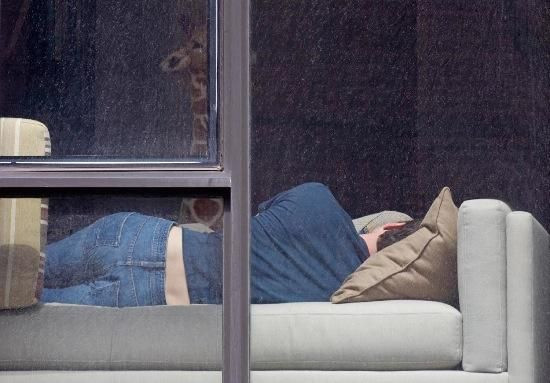Arne Svenson, Photographer Who Spied On Tribeca ‘Neighbors,’ Wins Legal Battle In Privacy Court Case

The Tribeca artist who secretly snapped photos of his across-the-street neighbors won a decisive victory last week when a Manhattan judge dismissed a legal complaint filed by the parents of two of his underage subjects.
In a court decision on Friday, State Supreme Court Judge Eileen Rakower ruled in favor of Arne Svenson, whose controversial exhibit “The Neighbors” featured photos of New York apartment-dwellers taken without their consent. Using a telephoto lens, Svenson took pictures through his neighbors’ windows at the Zinc building, a luxury Tribeca condo with floor-to-ceiling glass windows. Svenson lives across the street from the building.
In a blog post Monday, Mickey Osterreicher, general counsel for the National Press Photographers Association, posted the judge’s decision.
As IBTimes reported in May, many of Svenson’s neighbors became outraged when they’d learned of the exhibit, which had recently opened at a Chelsea gallery. Adding to the controversy was the fact that some of his photos included images of children. While Svenson was careful to obscure the faces in the photographs, many neighbors still felt the photographer had violated their privacy.
That same month, two of Svenson’s neighbors -- Martha and Matthew Foster -- filed a legal complaint seeking a preliminary injunction to prohibit Svenson from displaying or disseminating some of the photos, which included images of their young children. The couple argued that Svenson’s commercial use of the photos violated their civil rights.
New York civil rights law includes certain protections for people whose images are used commercially without their consent. If the Fosters’ children turned up on, say, a Verizon billboard ad, they would have clear cause for an injunction, as the use of images in advertisers requires consent.
But privacy laws are limited when they clash with the First Amendment’s guarantee of free speech. News organizations, for instance, do not need permission to publish or broadcast newsworthy images, despite the fact that most news organizations are commercial ventures. Likewise, art photographers do not need the consent of the subjects they use in artistic photographs.
It was in this context that Rakower denied the injunction and dismissed the case, calling Svenson’s work a form of art, through which he communicates his “thoughts and ideas to the public.” The Fosters, consequently, argued that Svenson’s photographs were a form of advertising, since they were on sale at the exhibition and available for purchase online.
However, the judge saw it differently. “The value of artistic expression outweighs any sale that stems from the published photos,” she wrote.
Also factoring into the decision was the fact that the “Neighbors” exhibit is now closed and Svenson has removed the photographs in question from his website and Facebook page.
Friday’s decision is the first legal test of what is largely uncharted area. Svenson is not the first artist to take photos of unsuspecting people in their homes, but the high profile of the “Neighbors” exhibit is likely to entice others to explore similar methods. In her ruling, Rakower focused primarily on whether or not the use of Svenson’s photographs qualified as advertising. Left largely undiscussed was Svenson’s method of capturing the images with a telephoto lens, which presumably allowed him a vantage point far more intimate than would be granted to the average Zinc-building passerby. Should copycat Svensons become emboldened by Judge Rakower’s decision, it’s likely only a matter of time before the legal details of this emerging genre (let’s call it Living Room Art) are revisited by a future court.
Rakower, for her part, hinted at the ethical ambiguity of Svenson’s method, but law and legal precedent won out in the end.
“While it makes the plaintiffs cringe to think their private lives and images of their small children can find their way into the public forum of an art exhibition, there is no redress under the current laws of the State of New York,” she wrote.
Read Judge Rakower’s full decision here.
© Copyright IBTimes 2025. All rights reserved.






















